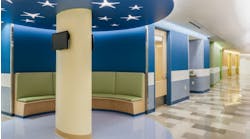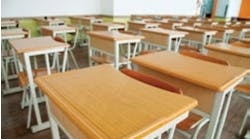In many learning environments, acoustics are less than acceptable. Poor acoustics inhibit productivity and contribute to lower test scores.
Classroom Acoustics by the Acoustical Society of America says that in many classrooms, listeners with normal hearing can understand only 75 percent of the words read from a list. Deficient acoustics can cause even more problems for students who are English language learners or who have learning disabilities or auditory-processing problems. Young children also are more vulnerable because if they miss a few words, they are less able than older students to “fill in” the missing thoughts.
Virtually everything affects a building's acoustics: room volume and configuration; hard and soft surfaces; floors, walls, ceilings, doors, windows and room dividers; furniture, fixtures and equipment; activities and occupants; mechanical, electrical and technology systems.
Masonry and sealant cracks, foundation settlement and concrete floor cracks, moisture and humidity damage, and deteriorating sound barriers in walls, ceilings and folding partitions leave openings for sound penetration. Noise and vibrations from heating and cooling systems usually are the primary source of background noise in classrooms.
Three factors can help achieve a good listening environment:
-
Avoid the speech-blurring effects of reverberation in a classroom with good internal acoustics.
-
Eliminate distraction created by remote sounds from interior adjacent rooms or corridors, and exterior sounds generated by street or air traffic noises and playgrounds.
-
Reduce background sound from HVAC equipment.
The American National Standards Institute's Acoustical Performance Criteria, Design Requirements, and Guidelines for Schools (ANSI S12.60) deals with four acoustical issues in classrooms: room acoustics; HVAC and electrical noise; classroom sound isolation from both interior and exterior sources; and impact isolation for multi-story classroom facilities.
The Air Conditioning and Refrigeration Institute (ARI), which has opposed adoption of the ANSI S12.60 provisions, commissioned a study and concluded that meeting ANSI S12.60 requires:
-
Care in selecting, situating and applying HVAC equipment.
-
Additional costs between 4 and 25 percent for classroom areas to meet the requirements.
-
Closer supervision during construction to achieve the expected design; partition walls that did not meet the standard failed mainly because of poor construction quality.
Improving classroom acoustics adds costs. However, the increased construction costs are not significant compared with the importance of creating a healthful learning environment.
Rydeen, FAIA, is an architect/facility planning specialist and former president of Armstrong, Torseth, Skold & Rydeen, Inc. (ATS&R), Minneapolis.


